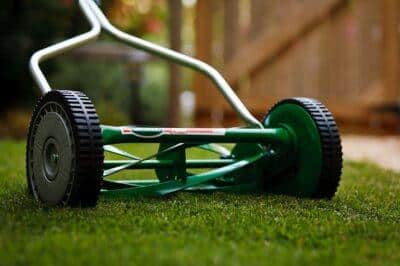Unless you happen to be a multi-millionaire who owns oil wells and a refinery, you won’t be able to be 100 percent self-sufficient. Unfortunately, gasoline is most likely a key part of your life.
So one key element of living off the grid sustainably is to try and eliminate or limit the amount of gas that you use. One of the homesteading chores that can require a lot of gasoline is yard care. From your mower to the weed trimmer to the chainsaw, you can burn a lot of gas just maintaining your yard. Thankfully, there are plenty of alternatives that don’t require gas, and can provide you with a healthier yard.
Limiting the grass you need to cut is key. There are countless ways to do this, from installing a patio to adding another garden bed. You can turn that part of your yard into something more productive and usable pretty easily.
You can also have what is called a “xeriscape” yard. Typically used in places that are facing limited water access, xeriscaping means planting native, drought-tolerant plants, as well as adding lots of pervious material to the yard, such as beds of river stone.
Discover More Than 1,000 Secrets For A Healthier, Safer Off-Grid Life! [2]
Xeriscaping can use as much as two-thirds less water, and by eliminating grass that needs to be cut on a regular basis, xeriscaping will also drastically cut the amount of yard care you need to perform, and will then practically eliminate the need for gas-powered tools.
One other highly effective way to limit the wide open grass you have is to install a solar array. The shade from the panels will naturally limit the amount of grass that will grow. They can also provide shelter for animals to get out of the sun on hot days, and provide you with all of your electricity needs.
If you still need to use gasoline tools to maintain your yard, you have some other options that will limit the involvement of gas. People were cultivating lawns and yards before petroleum machines were available, and the one of best way to limit the gas needs of your lawn are to look back in history.
Here are some of the tools you can use in lieu of their-gas powered counterparts.
1. Reel Mower. You probably have seen an older push reel mower at some point in your life, and there’s a reason for that. They were extremely popular before gas mowers, and due to recent surges in gas prices, they are becoming popular again.
A well-sharpened and oiled reel mower can save you a fair amount of money every year, but also has a couple of other benefits as well. First, push mowers are quiet, you will get a better workout from mowing the lawn, and you will reduce the air pollution that a gas mower produces. Due to their inefficient engines, a gasoline mower can produce enough smog to equal nearly four hours of driving a car. And, since you’re basically standing directly on top of the smog emissions, a push mower is far better for your health.
2. Scythe. Pronounced “sith,” this handy tool can be used for a variety of projects around the yard, from clearing brush to harvesting wheat. The curved handle and long, curved blade have been perfected over generations of use, and if you keep the blade sharp, this tool can accomplish a lot for you in a very short time.
The story continues below video
I had a stand of poplar trees slowly encroaching into my horseshoe pit area, and the scythe took care of them with just a few swings. But they’re great for cutting hay or tall crops as well, and will give you a great upper-body workout, too.
New Lantern Provides 100,000 Hours of Emergency Backup Lighting With No Open Flames [3]
3. Grass Whip. Basically a golf putter with an eight inch or so serrated blade at the end, a grass whip is handy for getting into areas for which the scythe is too big.
The story continues below video
The grass whip can be used as a trimmer near the edge of building, fences or walls, and the serrated blade means that you shouldn’t have to swing anywhere near as hard to cut back the grass. The whip is too small for use on anything too big, but handles grass fantastically.
4. Buck Saw. If you’re cutting up a couple dozen cords of wood for heat, you may want to keep that gas chainsaw in good running order. But let’s face it: A good buck saw can serve most of the purposes you need while in the yard. Trimming low-hanging branches and cutting small trees down are easily handled by a buck saw.
There are plenty of options available to help you cut down on the amount of gas you need to care for your yard. With a little research and planning, you may be able to eliminate the need for gasoline at all. And you will probably be healthier, more active, and even a little bit richer.
What advice would you give someone considering no-grass yard care? Share your tips in the section below:

